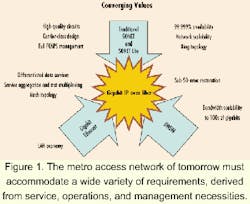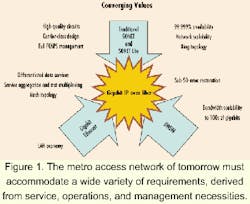How to build a 21st century metropolitan access network
With a variety of approaches to creating metro-network infrastructure, how is a carrier to choose?
Dr. Robert Kalman and Jay Shuler
Luminous Networks Inc.
Service providers deploying metropolitan access networks (MANs) have a tremendous opportunity. Local-area-network (LAN) capacities are exploding, supported by the availability of low-cost Gigabit Ethernet equipment. At the same time, DWDM technology has led to a huge increase in the bandwidth available in long-haul backbone networks. MAN service providers can now bridge the gap between LANs and the backbone network with new technology that supports both legacy voice and private-line services, as well as new bandwidth-intensive applications and services.
Vast quantities of optical fiber are now being deployed in metro rings. Yet carriers face a bewildering array of new products developed to harness this fiber and address the next-generation MAN market. How is a service provider deploying a new MAN to sort through these offerings and choose the correct solution?
A great deal is going to be expected of the MAN in the future (see Figure 1). Most of the applications that will be carried over the network do not exist today, and many have not even been imagined. Many service providers are talking about replacing traditional DS-0, T1, and DS-3 circuits with native Ethernet service running at 10 Mbits/sec to 10 Gbits/sec, providing a host of packet voice, digital video, and high-speed data services first to businesses and ultimately to residential users. This will drive a circle of innovation in both network services and user applications that will help reshape the economic and social landscape of the 21st century.
To meet this challenge, the next-generation MAN must meet the following requirements:
- Scalability: Ability to scale to bandwidths of tens of gigabits per second and large numbers of nodes-many more than the 16-node limit of traditional SONET or SDH solutions.
- Low cost: Low cost per gigabit per second, low first-in cost, and low operational costs.
- Support for next-generation differentiated services: The network must support a wide variety of different physical interfaces. The network must also support service creation through extensive, software-based quality-of-service (QoS) control and must support monitoring/billing of these services through powerful service-level-agreement (SLA) monitoring capabilities. The most important of these new services will be based on Internet Protocol (IP).
- Support for legacy voice services: Although traditional circuit voice accounts for a rapidly decreasing percentage of total bandwidth, it is still an important revenue-bearing service and must be supported.
- Powerful, easy-to-use network management: Network management must provide extensive control and monitoring facilities, yet be very easy to provision and operate. The network- management system must also provide protection against misconfiguration, a cause of many network performance problems and outages.
- Robustness: 99.999% uptime, redundant hardware, ring topology support, and fiber protection/restoration.
Many approaches are currently being promoted as the "right" solution to the needs of the next-generation MAN. These products can be classified into three categories: (1) SONET multiservice provisioning platforms (MSPPs); (2) Layer 2/3 packet switches; and (3) metro DWDM platforms.
The legacy of the voice-optimized network and SONET-based equipment continues to linger, even in the new generation of products supposedly optimized for an IP-centric world. Many of the recent technologies being introduced to the market are based on new mappings of circuit-switched payloads into SONET frames. These products-sometimes referred to as SONET MSPPs-map traffic into different circuit "pipes" such as SONET STS-Ns or new proprietary pipes. There are also numerous ATM virtual-path ring switch products based on ATM over SONET.Many of these SONET/circuit products support Layer 2 and Layer 3 packet-switching functions but implement them as additional layers on top of the SONET/circuit layers. In this sense, they are just bolting switches and routers on top of SONET add/drop multiplexers (ADMs), even if those ADMs use nonstandard SONET payload mappings. As a result, they tend to be expensive, difficult to implement and manage, and make inefficient use of fiber bandwidth due to the excessive overhead associated with multiple packet/ cell/framing layers. In particular, the need to manage multiple connection-oriented and connectionless layers makes them expensive to own and operate.
Coming from the LAN are native packet-switched solutions based on Layer 2 switches or Layer 3 routers connected by point-to-point links running Ethernet, packet-over-SONET, or some other protocol. These approaches fail to provide the QoS and robustness required for transport of real-time mission-critical services because they do not provide mechanisms to guarantee end-to-end packet delivery with well-controlled latency, bandwidth, and packet-loss characteristics. Most of these solutions do not provide management and billing statistics that are necessary for fault isolation and for billing multiple customers sharing a single node or network. Because they come from the enterprise-networking world, they also lack the carrier-class hardware and software robustness that is required in the public network.
A third group of vendors is trying to adapt backbone optical transport technologies to the MAN. Metro DWDM transport platforms provide a significant increase in ring capacity based on their ability to multiplex 32 or more signals over a single fiber by mapping each signal to a different wavelength. Most of these platforms provide some form of basic ring protection switching and can transport a variety of different traffic types in a "protocol-independent" manner. But because these metro DWDM platforms typically map a given input stream onto its own wavelength, they do not provide a means for efficient, flexible aggregation of lower rate streams onto the expensive DWDM facilities. Additionally, optical connectivity at the wavelength level is not dynamically provisionable because it is based on fixed- wavelength transmitters and multiplexers/demultiplexers.Some "second generation" metro DWDM platform vendors are beginning to bolt SONET ADM or crossconnect functionality on top of the WDM layer to achieve some aggregation and dynamic provisioning functionality in the form of multiple SONET rings, with each ring using one wavelength. However, in doing this, they sacrifice protocol independence and incur all the costs, inefficiencies, and inflexibility of standard SONET platforms.
"Old World" thinking dictates that it is necessary to introduce circuit layers to achieve end-to-end QoS guarantees. This is an outdated assumption that must be discarded when planning the 21st century MAN. The deficiencies of native packet-switched solutions arise not from the absence of additional circuit layers, but from the fact that they cannot manage network resources (e.g., span bandwidth, buffers) in response to service-level commitments.
The solution to this problem is not to add more circuit or protocol layers, but instead to enhance the existing layers and to add network-level intelligence to coordinate network resource management (see Figure 2). The robustness associated with SONET is readily achieved by adding performance monitoring, automatic protection switching, and embedded operations support to an existing packet-oriented Layer 2 protocol.
Once planners have shaken free of their 20th century assumptions, several key factors become clear:
- MANs must be optimized for IP transport. IP will be the dominant type of traffic transported in next-generation MANs. Optimizing for IP transport allows flexible creation and support of new services and minimizes equipment and operating costs.
- The optimal way to transport IP traffic is over a packet-switched network with a minimum of intermediate circuit layers. "Optimal" in this context means lowest cost, most scalable, most efficient, most flexible, and easiest to manage.
- Though the MAN should be optimized for IP transport, a successful MAN solution must support legacy services, most notably circuit voice and video.
- A packet-switched network can achieve acceptable QoS guarantees only through a network operating system in which intelligent traffic planning is tightly integrated with underlying resource management mechanisms (e.g., queuing engines, schedulers, and ingress traffic policing).
- SONET-based physical-layer transport is fundamentally expensive due to stringent jitter requirements and the requirements for specialized overhead processing resources (both hardware and software).
- Addition of extra circuit-switched layers adds unnecessary system complexity and cost, decreases network efficiency, and makes network provisioning more complex and time-consuming.
Next-generation MANs demand a solution optimized for differentiated IP-based services. At the same time, these next-generation MANs must provide support for today's legacy voice services, which continue to provide a significant source of revenue for service providers. These objectives can be achieved only through a packet-switched network that provides end-to-end service guarantees in terms of latency, bandwidth, and packet loss.
Fortunately, these solutions are now becoming available. Considerable innovation by a handful of vendors already has been demonstrated in public forums and is now in customer beta test labs. In addition, work has begun in the IEEE 802.17 Resilient Packet Ring Study Group, which is expected to become a formal working group by the time this article is published. This work will drive new standards to enable service providers to generate new revenues through high-bandwidth, differentiated data services, while preserving legacy revenues at fundamentally lower cost points. These next-generation MAN providers will ride a new cost curve, while reshaping the service landscape of the 21st century.
Dr. Robert Kalman is director, assistance engineering, and Jay Shuler is vice president of marketing and business development at Luminous Networks Inc. (Cupertino, CA). Shuler can be reached at [email protected].


